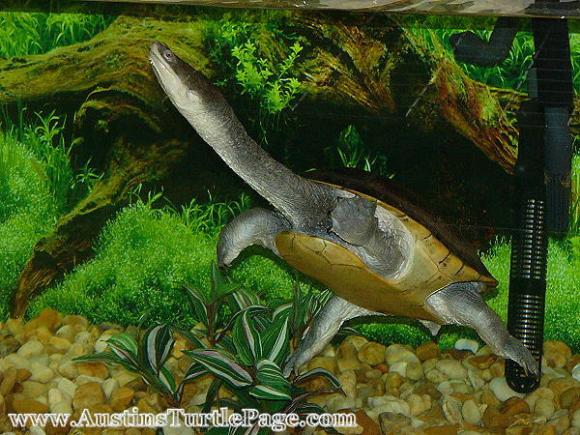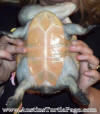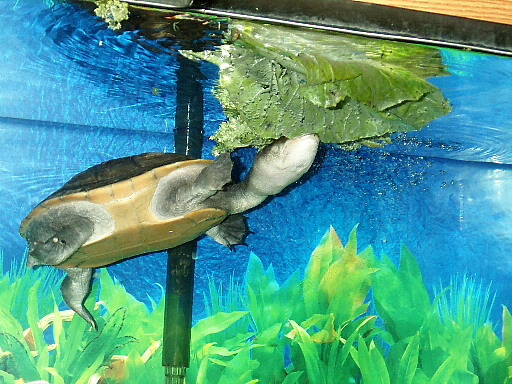|
|
|
|
|
Carapace: The carapace is typically brown and somewhat elongated with the broadest portion of the shell being just past the middle. The scutes have small creases or wrinkles and are either brown or black in color. The posterior edge of the carapace is most often smooth but can sometimes be slightly serrated. The underside of the carapacial rim is light brown to yellow. Plastron: The front of the plastron is wide and tapers to a rounded edge while the rear tapers down with a deep notch. The plastron is smaller than the carapace and the bridges are narrow. Both the plastron and the bridges are yellow and can sometimes have dark seams. Head: The head is large, wide and long and covered with irregularly shaped scales with the nose staying within the curvature of the head. The top jaw has neither cusp or notch bottom jaw is flat with small, multiple chin barbels. The neck is thick and very long (more than 75% of the length of the carapace) and is covered with a variety of tubercles along its length.The head and neck are usually gray, brown or olive in color with the underside usually being a lighter variant of the top and can sometimes be white. Additional: The limbs and the tail of Macrochelodina rugosa are usually a mild gray. Males have a much longer and thicker tail than females. They also possess several large, transverse scales on the front of the front legs. Size: .Both males and females may attain a SCL of between 14" and 16 inches. |
||
|
|
|
|
|
|
|
|
Can be found along the northern edges of Australia
(Cape York Peninsula west to the Kimberly District of western Australia)
|
||
|
|
|
|
|
|
|
|||||
|
TEMPERATURE RANGE (°F)
Some keepers have kept rugosa long term successfully in water temperatures in the range of 74 - 76 degrees.
Due to their size (not just the carapace length but also taking into consideration their neck) these turtles can be difficult to house, hence their being classified as an intermediate difficulty level. Not many beginning keepers are able to keep a species that can attain this size with the additional length of the neck. It can make for some interesting housing challenges. Additionally, as this species are not common baskers, they can sometimes develop shell situations which require treatment. CAPTIVE DIET As with all turtles, variety is the key to success. While it is believed that rugosa are indeed true carnivores, they will sometimes accept leafy greens and veggies. In feeding a carnivorous/omnivorous turtle, it is commonplace to freeze their food for storage purposes but it should be thawed completely before offering to your turtles. Commercial foods on the market are availabe, such as Mazuri Aquatic Turtle Diet, AquaMax 500 and ReptoMin. Live should should be provided routinely for feeding such as prawns and fish. Bloodworms, blackworms, earthworms, snails, crickets and other insects are also encouraged as a part of their captive diet.
RECOMMENDED FEEDING SCHEDULE Most rugosa lose any shyness relatively quickly and are voracious feeders. They appear to take on the "eat it now, taste it later" concept when feeding. Their strikes are indeed snake-like and adult rugosa especailly have a powerful bite so it is common to overfeed them due to the entertainment value of watching them feed. I recommend feeding adults twice per week while sub-adults get fed 3 times per week. Juveniles should only be feed possibly every other day while fresh hatchlings should get a daily meal. When feeding, it is important to ensure they receive a quality amount without overstepping the boundaries and falling into overfeeding. A good rule of thumb is to feed them enough pellets that will fit into their head or when feeding thawed live food, you should feed sparingly. CAPTIVE HABITAT M. rugosa are not basking creatures. They have been known to bask, however, it's most definitely a rarity. A basking area should be provided. Over the years, I have my rugosa with several habitats and basking options, of which none have been seen to have basked more than once or twice in 8+ years. Because of this, I have gone ahead and removed the basking area and replaced it with a shallow water shelf and this has become a favorite place for hanging out and sleeping. RECOMMENDED ENCLOSURE These turtles require a sizeable enclosure not only because of their size, but they are active turtles. When selecting a habitat for this species, keep not only carapace length in mind, but also neck length (potentially 75% of the length of the carapace). While not recommended for indoor set-ups, adults can be housed in aquariums no smaller than 150 to 200 gallons for a single turtle. Adding additional turtles to a habitat requires that you increase the size of the tank accordingly by half (ie; 1 male = 150 gallons, 2 males = 225 gallons, etc). Stock tanks also make great alternatives to glass an acrylic aquariums. As everything on this website, these are recommendations and not hard-set "must do" rules. WATER DEPTH Accomplished swimmers even as fresh hatchlings, Macrochelodina rugosa enjoy deep water habitats. COMMUNITY HABITAT Most do extremely well with other turtles from the same climate and are generally docile towards tankmates, although, as with any species, there are individuals who show aggression towards other turtles even when adequate room is provided. |
|||||||
|
|
|
|
|
|
|
|
Macrochelodina rugosa will lay their eggs
in shallow water during the late wet/early dry season. When the dry season
comes, the water level drops and air enters the nest and triggers
development of the embryos inside the eggs. They can may between 10 and 16
elongated eggs.
|
||
|
|
|






